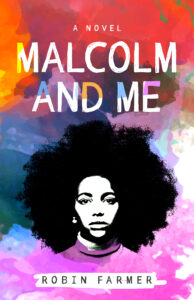
Malcolm and Me
Robin Farmer
SparkPress
Published November 17, 2020
Amazon | Barnes & Noble | Book Depository | Indiebound | Goodreads
About Malcolm and Me
Philly native Roberta Forest is a precocious rebel with the soul of a poet. The thirteen-year-old is young, gifted, black, and Catholic—although she’s uncertain about the Catholic part after she calls Thomas Jefferson a hypocrite for enslaving people and her nun responds with a racist insult. Their ensuing fight makes Roberta question God and the important adults in her life, all of whom seem to see truth as gray when Roberta believes it’s black or white.
An upcoming essay contest, writing poetry, and reading The Autobiography of Malcolm X all help Roberta cope with the various difficulties she’s experiencing in her life, including her parent’s troubled marriage. But when she’s told she’s ineligible to compete in the school’s essay contest, her explosive reaction to the news leads to a confrontation with her mother, who shares some family truths Roberta isn’t ready for.
Set against the backdrop of Watergate and the post-civil rights movement era, Angel Dressed in Black is a gritty yet graceful examination of the anguish teens experience when their growing awareness of themselves and the world around them unravels their sense of security—a coming-of-age tale of truth-telling, faith, family, forgiveness, and social activism.
My Review
I keep writing sentences that start with, “My favorite thing about this book…” and then I remember something else equally as awesome as the thing I was originally going to call my favorite.
I loved a LOT about this book. The characters are complex. Roberta, at fourteen, is just beginning to discover that she can admire and despise things about the same person. I loved that that lesson was repeated in her relationships with multiple characters in the story.
MALCOLM AND ME definitely challenged me. I feel like, at the beginning of the story, I wanted to doubt Roberta’s perceptions of things sometimes. Or offer more benefit of the doubt than she was comfortable offering. A couple of times I paused in my reading to think that through and made a conscious decision to listen to her story and see where it all went before making any judgments.
I feel like I grew as a reader, but I also think Roberta’s story was so rich and compelling that she would have pulled me along with her no matter what. But I know I really deeply loved the way MALCOLM AND ME explored relationships, particularly her relationship with the nun who used racist insults to humiliate her and with her father, who she learns has some troubling secrets.
Through all this, she continues to evaluate her faith in God– sometimes rejecting belief out of anger, other times being swallowed by her guilt, and still other times leaning into prayer and faith as a means of bringing her through dark moments.
She also connects things that happen to her to the life of Malcolm X, whose autobiography she has been reading. I thought it was really cool the way the story showed a progression in her thinking there, too. Sometimes she was drawn to the hardness of some of this words. At other times, she was drawn to the things he said later in his life, more about peace and treating white people as brothers.
Roberta’s confidence can’t help but be inspiring. Her commitment to think deeply and explore issues and her leadership definitely moved me. I loved this book. I want to see it in classrooms and community libraries, and I hope it inspires many conversations about race and history and faith. I absolutely recommend MALCOLM AND ME.
If you missed it yesterday, please check out my Q&A with author Robin Farmer for lots more insight on this fantastic book.
Content Notes
Recommended for Ages 12 up.
Representation
Roberta is Black and attends a mostly white Catholic school.
Profanity/Crude Language Content
Strong profanity used infrequently. Some racial slurs, including use of the N-word.
Romance/Sexual Content
Some vague references to men having affairs. Several times Roberta comments on curvy women and the men around them eyeballing those curves.
Spiritual Content
Roberta attends Mass and confession. She and other characters pray sometimes. Sometimes she doubts her faith.
Violent Content
A woman slaps a girl multiple times. The girl hits her back in the chest. A woman punches a wall in the midst of an argument. Two boys get into a fistfight.
Drug Content
None.
Note: I received a free copy of MALCOLM AND ME in exchange for my honest review. This post contains affiliate links, which do not cost you anything to use, but which help support running this blog.